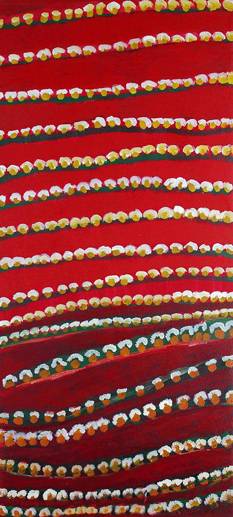PIJAJU PETER SKIPPER (dec)
Japirnka Ceremony
PC012/02 (2002)
Acrylic on Canvas
121.5 x 91cm | 47.83 x 35.83in
Mangkaja Artists
ENQUIRE
Provenance
Mangkaja Art CentreMichael Reid (in conjunction with Wally Caruana)
Private Client - Melbourne
PIJAJU PETER SKIPPER (dec)
Larripuka
pc250/99
Acrylic on canvas
120 x 90cm | 47.24 x 35.43in
Mangkaja Artists
ENQUIRE
PIJAJU PETER SKIPPER (dec)
Juwaris
pc014/02 (2002)
Derivan Matisse Acrylic on 10 oz Cotton Duck
91 x 76cm | 35.83 x 29.92in
Mangkaja Artists
ENQUIRE
Peter Skipper is a Juwaliny / Walmajarri man who was born 1929 in the Great Sandy Desert of Western Australia at a place called Japingka. Peter, a bushman, had his first contact with kartiya (whitemen) when he was a young man. Peter travelled with his young wife Jukuna and other relations who drifted away from their countries to cattle stations in the Southern Kimberley in the early 1950s.
Peter, like many others who drifted away from their country worked on a cattle station. He worked as stockman for 20 years before moving his family to Fitzroy Crossing in the 1960s. They lived in the Old Mission area in Fitzroy Crossing. Other relations moved into the Old Mission so their children could attend the Mission School. Peter said," I did my schooling out in the bush when I was a young man my father taught me". Peter a strong man about his culture learnt how to drive a car and was taught how to read and write Walmajarri (Language). In 1986 Peter wrote two books in language which tell about his early life in the
Great Sandy Desert.
Peter is a leader of the Walmajarri people and a respected Aboriginal law man who still has a clear mind about names of his country. Peter started painting because he worries a lot about his country Japingka, a Jila (living waterhole). Japingka is a spiritual place, owners of the Jila (living waterhole) would sing to make the rain come. People travelled long distances to practice their culture there. It was like a big festival, it was our way of doing things.
Its been a long time for the Walmajarri people to go back and visit their mothers and fathers country. Peter and many other relations are now going back to their country to claim what they left behind. Peter and relations visit birth places, sacred sites, to sing traditional songs, paint their part of country and to clean the waterholes. Many of these haven't been lost. We are still strong with our culture and the desert is still our home land.
Peter Skipper is a Juwaliny / Walmajarri man who was born 1929 in the Great Sandy Desert of Western Australia at a place called Japingka. Peter, a bushman, had his first contact with kartiya (whitemen) when he was a young man. Peter travelled with his young wife Jukuna and other relations who drifted away from their countries to cattle stations in the Southern Kimberley in the early 1950s.
Peter, like many others who drifted away from their country worked on a cattle station. He worked as stockman for 20 years before moving his family to Fitzroy Crossing in the 1960s. They lived in the Old Mission area in Fitzroy Crossing. Other relations moved into the Old Mission so their children could attend the Mission School. Peter said," I did my schooling out in the bush when I was a young man my father taught me". Peter a strong man about his culture learnt how to drive a car and was taught how to read and write Walmajarri (Language). In 1986 Peter wrote two books in language which tell about his early life in the
Great Sandy Desert.
Peter is a leader of the Walmajarri people and a respected Aboriginal law man who still has a clear mind about names of his country. Peter started painting because he worries a lot about his country Japingka, a Jila (living waterhole). Japingka is a spiritual place, owners of the Jila (living waterhole) would sing to make the rain come. People travelled long distances to practice their culture there. It was like a big festival, it was our way of doing things.
Its been a long time for the Walmajarri people to go back and visit their mothers and fathers country. Peter and many other relations are now going back to their country to claim what they left behind. Peter and relations visit birth places, sacred sites, to sing traditional songs, paint their part of country and to clean the waterholes. Many of these haven't been lost. We are still strong with our culture and the desert is still our home land.
![Australian Indigenous (Aboriginal and Torres Strait Islander) artwork by PIJAJU PETER SKIPPER of Mangkaja Artists. The title is Japirnka Ceremony. [PC012/02] (Acrylic on Canvas)](https://media.redotgallery.com/stockroom/gallery/j/artwork/p/japirnka-ceremony-6326-MEDIUM-2.jpg)
![Australian Indigenous (Aboriginal and Torres Strait Islander) artwork by PIJAJU PETER SKIPPER of Mangkaja Artists. The title is Larripuka. [pc250/99] (Acrylic on canvas)](https://media.redotgallery.com/stockroom/gallery/l/larripuka-163-MEDIUM.jpg)
![Australian Indigenous (Aboriginal and Torres Strait Islander) artwork by PIJAJU PETER SKIPPER of Mangkaja Artists. The title is Juwaris. [pc014/02] (Derivan Matisse Acrylic on 10 oz Cotton Duck)](https://media.redotgallery.com/stockroom/gallery/j/juwaris-438.jpg)
